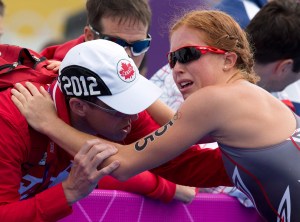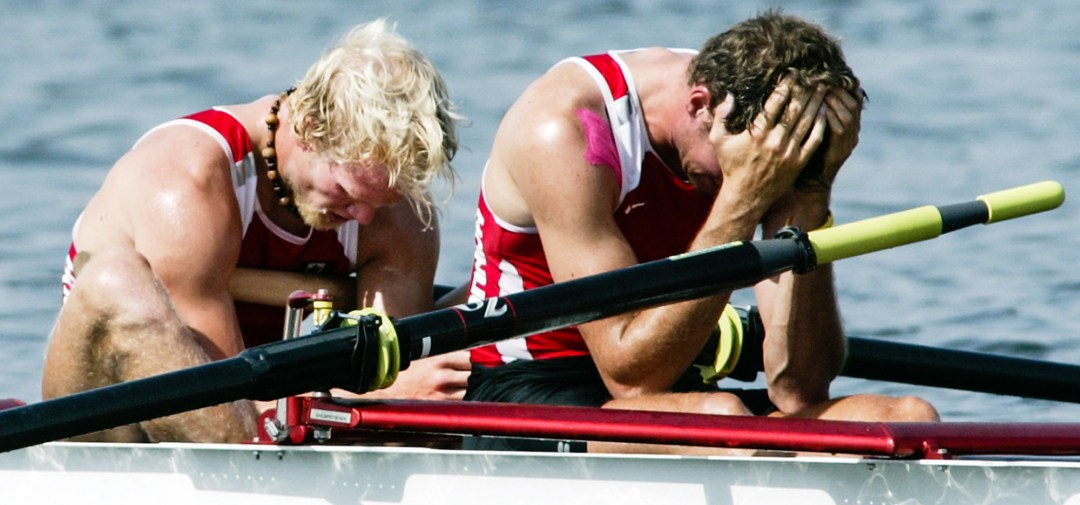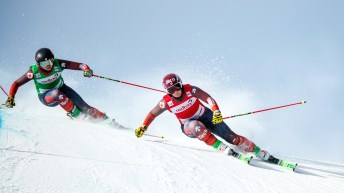How to keep calm and carry on
When the members of the Canadian men’s eight rowing team walked into the Olympic Stadium in Athens for the Opening Ceremony of the 2004 Games, they were considered all but a sure thing to bring home the gold. But they didn’t. Not only did they missed the gold, they failed to medal, falling to fifth place in the final.
This devastating defeat, however, made their 2008 gold medal win in Beijing all the sweeter and the man behind the team’s redemptive victory was head coach Mike Spracklen.
“Mike Spracklen creates the most demanding training regimen in the world,” wrote team member Adam Kreek in a blog for CBC Sports. “He doesn’t just pressure his athletes with volume and intensity of work. He constantly presents opponents to compete against.”
“The athletes were free to make a choice in their intent to commit to work harder and better than any other athlete in order to achieve their personal best.”
Spracklen’s successful coaching strategy goes beyond the rigors of his training program, says Veronica Planella, a sports psychology consultant and 1995 PanAm bronze medallist in field hockey who currently teaches at the School of Exercise Science and Physical Education at the University of Victoria and is also a coach for the Pan-American Field Hockey Federation.
“After the Athens loss, Spracklen invited team members to rethink their commitment to the sport,” she says. “He created an environment with clear expectations where he constructed training situations in which the desired goal exceeded their current level of performance. The athletes were free to make a choice in their intent to commit to work harder and better than any other athlete in order to achieve their personal best.”
This personal commitment is the key to an athlete’s motivation, says Planella, adding that a coach cannot be successful unless their athletes are highly motivated.
“Motivation is the driving force that will direct your thoughts and behaviours that ultimately help you persevere when experiencing a challenge. Motivation promotes engagement. This, in turn, increases opportunity to experience and reflect on improvements, thus developing a sense of control and confidence, which leads to success, which reinforces motivation continuous loop.”
THE TASTE OF DEFEAT
With a 28-year history of coaching high-school basketball, club teams and men’s leagues, Steve Gazmin of Toronto has been subjected to his share of losses. From experience, he has learned to adjust his comeback coaching tactics according to the cause of the defeat.
“When we lose because we didn’t try hard enough or the other team out-willed us, I tell my players to remember how losing tastes and feels. I want them to learn to hate that taste,” he says, adding that he almost feels sorry for the next team they play after a bad loss.
When his team loses due to lack of talent, on the other hand — that is, the other team demonstrated superior skills — then Gazmin focuses on motivating his players to push themselves beyond their limits, to set higher expectation levels for themselves.
“If the other guy is better, that is the benchmark we have to set,” he says.
“I tell my players to remember how losing tastes and feels. I want them to learn to hate that taste.”
Perhaps more important than why a player or a team loses is how they perceive that loss, says Philip Sullivan, professor and department chair of the Department of Kinesiology at Brock University in St. Catharines, ON.
“How you attribute or explain a loss has a big impact on your confidence, which can affect your next performance,” he explains.
For example, a team that attributes a defeat to bad officiating might be able to diminish the loss with little impact to their confidence and subsequent performance compared to a loss that they attribute to their own inadequacies.
To help players regain their footing, Sullivan advises coaches to build confidence by focusing on process and self-comparison.
PROCESS TO PROGRESS
Sullivan coaches a youth basketball team from a small nearby community. His players are good, but because they always compete against larger communities that have a pool of taller and better talent, his team developed an expectation to lose. He helped turn that mentality around and convince his players that they can win by focusing on process.
“Sport is based on outcome, but there is a lot about outcome that you can’t control; for example, if all your basketball players are five feet tall and everyone on the other team tops six feet, the other guys are going to get more rebounds. Focusing on the process means building your players’ skills and emphasizing how they do what they should do,” he says.
Sullivan has the team practice skills and situations in which he knows they will perform well, and then gradually increases the level of difficulty as their confidence builds. This approach changes the focal point from winning and losing to defining success in terms of performance — for example, the number of times players get into the proper box out position. And rather than comparing their performance to others, players are told to focus on their own record — IE: whether their skills are improving over time.
This self-comparison helps build confidence, as players come to recognize that they have experienced a particular challenge in the past and found the resources that helped them respond in positive ways.
FOUR STEPS TO RESILIENCY

Ultimately, coaching an athlete to bounce back from defeat is about teaching self-regulation and resiliency, says Planella: “The coach’s role is to help the individual effectively regulate response to any situation and quickly adapt and develop a new strategy. How you react to setbacks determines your success”.
She offers this four-step approach:
1. Help the athlete understand what is required: The setback requires the coach and athlete to return to the drawing board and look for new opportunities to learn. Understanding the reason for the setback and the emotional response is the first step. Then, identify situation-specific tasks to be implemented in new strategy.
2. Set goals and plan: The athlete needs to understand why the goal is important, what didn’t work in the past and what options are realistic for the future. Then he or she has to choose to commit to putting in the physical, emotional and cognitive effort to achieve the new standard. Athletes are motivated when experiencing improvement. Therefore, effective goal setting will encourage persistence on daily tasks.
3. Try the new strategy: Actually do the task. The coach and the athlete would benefit from documenting and reflecting on whether the new plan is working. Review new strategies focusing on behaviours, cognition, emotions and levels of motivation.
4. Adapt: Is the athlete learning from his or her mistakes or repeating them? Is the coach providing the support and resources needed? Success will be the result of learning from experience and of continually striving to do better. These steps are cyclical, as coaches and athletes continuously monitor, reflect and evaluate their progress.
“When athletes take control of their own learning by being aware of and deliberately adapting what they do, what they think, and how they feel they will be better prepared to effectively manage any setback,” says Planella. “Developmental, recreational or elite contexts have distinctive goals that the coach would benefit from considering when implementing strategies to help athletes manage setbacks. Still, the value of persistency in developing resilience is a skill that requires shifting attention from a setback, perceived as a problem, to positive change — and it can gradually be learned from the developmental stages of sport involvement.
“Resilience is an important part of life, not just sport. We all have to learn how to use setbacks to our advantage,” says Planella. “The best coaches deliberately create environments that offer opportunities for the athlete to explore and discover new possibilities, and to develop values that will make the individual successful in both sport and life.”

THE ULTIMATE EXAMPLE OF BOUNCING BACK
Paula Findlay qualified for the triathlon event at the 2012 Summer Olympic Games but due to an injury, she finished in 52nd place, the final athlete to complete the race. Her coach Joel Filliol, ChPC explains her comeback strategy:
“Our approach has been to return to the basics. It’s the right time in many ways, after a challenging performance at the Games, where there were so many different factors involved. So we have been objective and rational about how Paula needs to grow as a person, and athlete. We put our efforts into establishing a sound foundation on conditioning, effective habits, and skills to handle the process, the inevitable ups and downs that are part of any athlete’s development. We can’t change the past, however we can learn from her experiences, and use that to move forward, and evolve.
“No athlete is the finished product, and Paula being just 23, having achieved some big successes, and faced some big challenges, we leverage all that into patience, perspective and focus on what we can control, moving forward a little bit each day.”
DEFEAT-BUSTERS: SUGGESTIONS FOR HANDLING SETBACKS
• Tailor the coaching strategy to the athlete’s stage of development. Younger players may need help understanding that setbacks can be opportunities to explore and develop new skill sets. With more mature athletes, coaches can work through a loss by reviewing their practice design and creating different scenarios for the players to practice. At a senior level, coaches may have to ask their athletes to reaffirm their commitment to their sport.
• Help athletes develop a multidimensional sense of identity exploring all different dimensions of their lives.
• Focus on the solution, not the problem.
• Document, monitor and reflect what works and what does not work. Learning from setbacks will occur only with an accurate review.
• Collaborate with your athletes to set realistic, measurable goals. Review them often.
• Create practice scenarios in which the athlete can be challenged yet perform well, building confidence to move on to more difficult challenges.
• Explain the natural process of ups and downs of training and competition.
• Communicate and celebrate progress.
• Monitor and reflect regarding your own behaviours and thoughts as to how your coaching interventions are helping or not helping your athlete.




